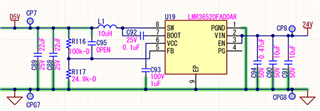Dear Specialists,
My customer is evaluating LMR36520 and encountering poor efficiency at a light load.
I would be grateful if you could advise.
---
When we prototyped the circuit of LMR36520 and measured the power conversion efficiency, the result was about 10% worse than the data sheet.
In the data sheet, 24V input, 0.1A load, 5V output, at least 80% or more.
Even when compared with the result of simulation with Webench, it is about 10% worse.
Request(1) Could you please let us know what is the cause of the inefficiency?
Request (2) Could you please confirm the efficiency of the datasheet.
The efficiency in our circuit
Input power: Vin 27.5V x Iin 46.8mA = 1.287W
Output power: Vout 5V x Iout 172mA = 0.86W
Efficiency: 0.86 ÷ 1.287 = 66.9%
Input power: Vin 19.6V x Iin 61.8mA = 1.211W
Output power: Vout 5V x Iout 171mA = 0.855W
Efficiency: 0.855 ÷ 1.211 = 70.6%
The input and output voltage is measured nearby the device.
Schematic

BOM
The result of Webench
LMR36520FADDAR using Custom Part.pdf
I appreciate your great help in advance.
Best regards,
Shinichi


